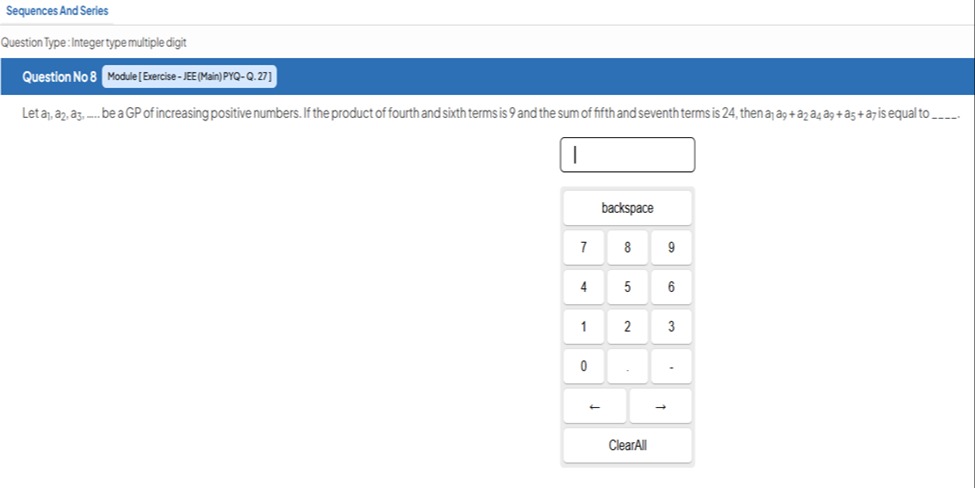Question
Question: Let $a_1, a_2, a_3.....$ be a GP of increasing positive numbers. If the product of fourth and sixth ...
Let a1,a2,a3..... be a GP of increasing positive numbers. If the product of fourth and sixth terms is 9 and the sum of fifth and seventh terms is 24, then a1+a2+a3+a4+a5+a7 is equal to .....

24 * ((50 + sqrt(7)) / 49). Note: This question is of integer type, but the actual answer is not an integer, so there is likely a typo in the original question.
Solution
Let the geometric progression (GP) be a1,a2,a3,… with first term a and common ratio r. The nth term of a GP is given by an=arn−1. Since the GP consists of increasing positive numbers, we must have a>0 and r>1.
Given conditions:
-
The product of the fourth and sixth terms is 9. a4⋅a6=9 (ar4−1)⋅(ar6−1)=9 (ar3)⋅(ar5)=9 a2r8=9 This can be written as (ar4)2=9. Since the terms are positive, ar4 must be positive. So, ar4=3. Note that ar4 is the fifth term, a5. Therefore, a5=3.
-
The sum of the fifth and seventh terms is 24. a5+a7=24 Substitute the value of a5=3: 3+a7=24 a7=21.
Now we have a5=3 and a7=21. We know that a5=ar4 and a7=ar6. Divide a7 by a5: a5a7=ar4ar6 r2=321 r2=7 Since the GP is of increasing positive numbers, r>1, so r=7.
Now we find the first term a using a5=ar4=3: a(7)4=3 a(72)=3 49a=3 a=493.
We need to find the value of a1+a2+a3+a4+a5+a7. Let's list the required terms: a1=a=493 a2=ar=4937=4937 a3=ar2=493(7)=4921=73 a4=ar3=493(77)=49217=737 a5=3 (as determined earlier) a7=21 (as determined earlier)
Now, sum these terms: S=a1+a2+a3+a4+a5+a7 S=493+4937+73+737+3+21 To add these fractions, find a common denominator, which is 49. S=493+4937+493×7+4937×7+24 S=493+4937+4921+49217+24 S=493+37+21+217+24 S=4924+247+24 Factor out 24 from the first term: S=4924(1+7)+24 Factor out 24 from the whole expression: S=24(491+7+1) Combine the terms inside the parenthesis: S=24(491+7+49) S=24(4950+7)
This expression is not an integer due to the presence of 7. Given that the question is of "Integer type multiple digit", it is highly probable that there is a typo in the question. However, based on the question as stated, the derived value is 24(4950+7).
If we assume the question meant a1+a2+a3+a4+a5+a6, then the sum would be: S6=∑k=16ak=ar−1r6−1 a6=ar5=493(7)5=493(497)=37. S6=a1+a2+a3+a4+a5+a6=4924+247+3+37 S6=4924(1+7)+3(1+7) S6=(1+7)(4924+3) S6=(1+7)(4924+147) S6=(1+7)(49171) This is also not an integer.
Given the problem type (integer type multiple digit) and the common nature of such questions in JEE Main, it's highly likely that the question has a typo and was intended to yield an integer answer. However, based on the exact wording, the result is not an integer. If this was a multiple choice question, one might look for the closest integer or re-evaluate the question's intent. As an integer type question, it implies an exact integer answer. Without further clarification or correction to the question, a non-integer result is obtained.
Assuming there is no typo and the question expects the exact calculated value, it is not an integer. However, in competitive exams like JEE, integer type questions always have integer answers. This usually means there's a specific pattern or simplification. Since 7 cannot be removed, it implies the question's premise might be flawed or there's a typo in the terms to be summed.
If the question had been a1+a3+a5+a7: a1=3/49 a3=3/7=21/49 a5=3 a7=21 Sum =493+4921+3+21=4924+24=24(491+1)=24(4950)=491200, still not an integer.
Given the constraints, the problem as stated does not yield an integer answer. If this is a real PYQ, there might be a typo in the question.
The final answer is 24(4950+7). However, since the question type is "Integer type multiple digit", and the answer is not an integer, there must be a typo in the question. If this was a real exam, one would typically re-check the problem statement or assume a typo. As an integer type question, it implies an exact integer answer. Without further clarification or correction to the question, a non-integer result is obtained.
Subject: Mathematics Chapter: Sequences and Series Topic: Geometric Progression (GP) Difficulty: Medium Question Type: integer
